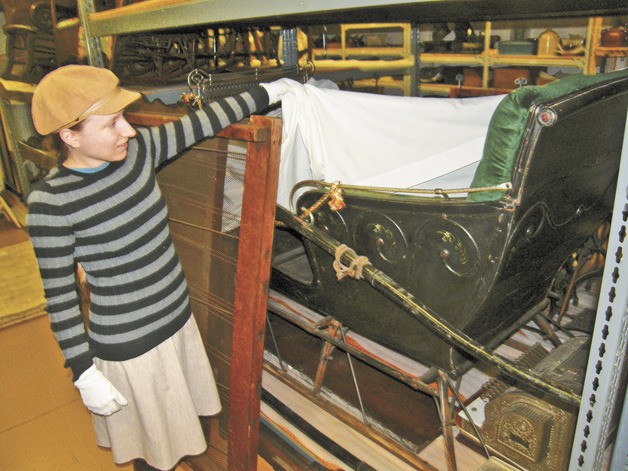Here an old wooden wheelchair, there a child’s sewing machine, way up there a farm gizmo, and that … uh, dunno what that did.
In the White River Valley Museum’s storeroom are stowed the riches of Auburn’s ages, bits of flotsam and jetsam cast up on the shores of time by the people who came before.
The collection includes oddities the public hardly ever sees because they don’t easily fit into exhibits. Granted, a can of oil for a Hammond organ is historical, but is it something people are eager to come and see? Is there an audience for a can of Acme brand embalming fluid? Yet, there they are. What to do with them?
Step into the collective attic of the community, Collection Curator Hilary Pittenger’s domain, a kingdom of old furniture, stiff crinoline dresses and shelves crammed with curios of bygone days.
First stop — testimony to the city’s colorful railroad past — a cart bearing beautifully wrought Northern Pacific dining car china. Not a whole set.
“We don’t really know where it was used,” Pittenger said.
Next to the cart is a fully-equipped Northern Pacific first-aid kit, graced with an unlikely yin-yang symbol. Nestling nearby are railroad semaphore switches and train models, so many models, said Pittenger, that the museum doesn’t know what to do with them.
“One of the biggest hits we get on our website at the museum, though, is for Morse code-related research requests,” Pittenger said. “People love this stuff, and we can teach kids about how people communicated, using telegraphs and telegrams.”

On the floor below the railroad artifacts squats an improbable washing machine, actually, half a barrel minus a few side slats, topped by a mystery ball.
“You crank this, this lid lifts up as you take this mechanism off,” Pittenger explained.
And the ball?
“Fantastic question,” said Pittenger. She paused to think. “Probably a soap dispenser, but don’t hold me to it.”
The collection includes an aluminum model airplane made by Italian prisoners of war who were stationed in Auburn during World War II at a camp rumored to be near today’s GSA on 15th Street Southwest.
High upon a shelf, a wooden World War I stretcher prompts the passerby to wonder, what soldiers did that litter bear away, and from what bloody battles?
On one shelf are four pieces of masonry that once graced a local building, handiwork of the long defunct Northern Clay Company
“We don’t think they’re odd, but most people don’t know that we have them,” Museum Director Patricia Cosgrove said of the masonry.
What tales of horror could yon dentist’s chair (inserted photo), with its “creepy leather head rest,” as Pittenger called it, tell of the days before high-speed dentist drills?
And just look at that horrific looking gizmo, a permanent wave machine with telltale dangling wires. Women once entrusted their heads to that bride of Frankenstein.
Who knows, maybe the museum’s resident spirit — a friendly ghost, Pittenger swears, never known to raise a single follicle on anybody’s neck — once attached its locks to those wires and stalks its eternal rounds in restless disbelief. Or maybe the blithe spirit fit into one of the dresses in the collection, cranked one of the churns, or sat before a sewing machine to mend grandpa’s best britches.
In whatever way artifacts come to the museum, come they do.
“Every single thing we have comes from donations,” Pittenger said. “Probably a third of our collection came from a big influx of things that had been given to the old historical society. And when the museum opened, a lot of people donated stuff too. So we have a lot of things from that era, about 1970, that people had in attics, turn-of-the-century things that belonged to their grandparents. Ever since then, it’s been all donations and happenstance.
“Once, someone donated a bunch of 1950s and ’60s home movie equipment that they happened to have,” she said. “We have things from businesses and different departments in Auburn, like fire or parks. They have old archives or old fun things that are just sitting around.”
Cosgrove said the museum is always looking for items to add to its collection.
“In general, I’m really excited when we get worn out gardening clothes from Japanese-American farmers, or brakemen’s boots, or caps, things like that,” Cosgrove said. “Nobody wants to save those, and certainly rarely do people think that a museum wants something that is tattered and worn of everyday use.”
But not every time-worn thing will do.
Cosgrove remembers with amusement the day a truck pulled up to the museum with a load of old toilets in the back.
“Want ’em?” asked the owner.
“Nope,” said Cosgrove.
“Well, we’re off to the dump then,” the owner said.
“Not exactly what we had in mind,” Cosgrove recalled dryly.

